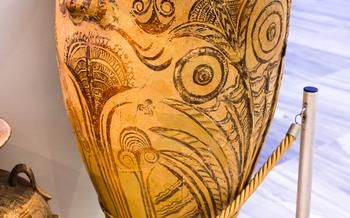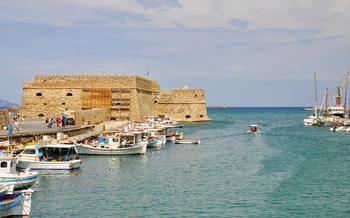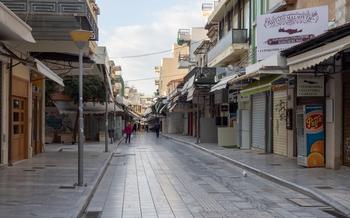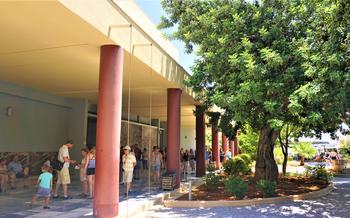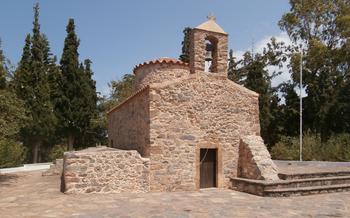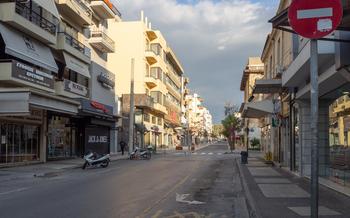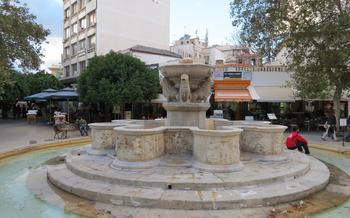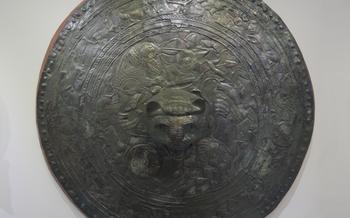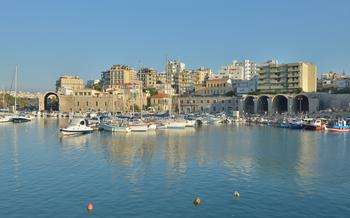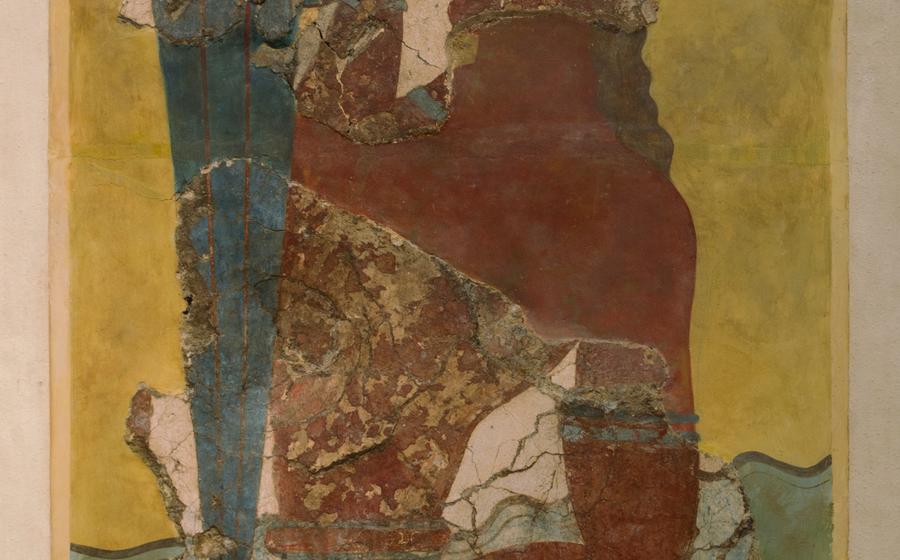
Knossos Palace
- Knossos Palace: A Journey Through Minoan Civilization
- Exploring the Grand Staircase: A Majestic Entrance
- Throne Room: Center of Power and Ceremonies
- Queen's Megaron: Unveiling the Royal Quarters
- Storage Rooms: A Glimpse into Minoan Economy
- Theatrical Area: Unveiling Ancient Performances
- Minoan Art and Frescoes: A Visual Feast
- Workshops and Craftsmanship: A Hub of Creativity
- Knossos and the Labyrinth Myth: Unraveling the Legend
- Nearby Attractions and Activities
- Historical Significance and Impact
- Preservation and Conservation Efforts
- Insider Tip: Unveiling Hidden Secrets
Knossos Palace: A Journey Through Minoan Civilization
History and significance of the palace
The Knossos Palace, located in Heraklion, Crete, is an awe-inspiring testament to the grandeur and sophistication of the Minoan civilization, which flourished on the island during the Bronze Age. Constructed around 1700 BC, the palace served as the political and ceremonial center of Minoan Crete for over 600 years. Its vast complex of buildings, courtyards, and workshops showcases the remarkable architectural achievements and artistic prowess of the Minoans. The palace's discovery in the early 20th century by British archaeologist Sir Arthur Evans unearthed a treasure trove of artifacts, frescoes, and architectural features, shedding new light on this enigmatic civilization.
Unique architectural features and design
The Knossos Palace's architectural design is a testament to the Minoans' ingenuity and creativity. Constructed primarily of mudbrick and stone, the palace features a complex layout of interconnected rooms, corridors, and courtyards. Its most notable feature is the grand staircase, a monumental structure that leads from the lower to the upper levels of the palace. The palace's unique features, such as the light wells, columned halls, and elaborate drainage system, demonstrate the Minoans' mastery of architecture and engineering.
Frescoes and artwork depicting Minoan culture
The Knossos Palace is adorned with vibrant frescoes, intricate paintings, and relief sculptures that provide a glimpse into Minoan culture and mythology. These artworks depict scenes of daily life, religious rituals, and mythical creatures, offering valuable insights into the beliefs, customs, and artistic traditions of the Minoans. The famous "Prince of the Lilies" fresco, showcasing a young man amidst vibrant flowers, is a testament to the Minoans' love for nature and their artistic prowess.
Archaeological discoveries and ongoing research
Knossos has yielded a wealth of archaeological discoveries, including pottery, tools, jewelry, and religious objects, which have helped scholars reconstruct Minoan society and culture. Ongoing excavations and research at the site continue to uncover new insights into the palace's history, architecture, and the lives of its inhabitants. These discoveries have shed light on the Minoans' trading networks, their religious beliefs, and their interactions with other civilizations in the ancient world.
Exploring the Grand Staircase: A Majestic Entrance
The Grand Staircase of the Knossos Palace stands as a testament to the architectural prowess of the Minoan civilization. This monumental staircase not only served as a functional passageway connecting the palace's different levels but also held significant symbolic and ceremonial importance.
Composed of broad, shallow steps, the staircase provided a graceful and imposing entrance to the palace's upper floors. Its architectural design showcased the Minoans' mastery of engineering, as it was constructed without the use of mortar, relying solely on the precise fitting of stone blocks.
The staircase's grandeur extended beyond its physical structure. It was adorned with vibrant frescoes depicting scenes of processions and religious rituals, adding to the awe-inspiring atmosphere of the palace. These frescoes served as a visual narrative, providing glimpses into the ceremonial and religious practices of the Minoan people.
The staircase also held symbolic significance, as it was believed to be a representation of the cosmic axis, connecting the earthly realm with the divine. This notion is reinforced by the fact that the staircase aligned with the rising and setting of the sun during the summer and winter solstices, creating a celestial spectacle that further enhanced the sacredness of the space.
Climbing the Grand Staircase to the palace's upper levels offers visitors breathtaking panoramic vistas of the surrounding landscape. From the top of the staircase, one can gaze upon the sprawling palace complex, the fertile plains of Crete, and the distant shimmering sea. These views provide a sense of the palace's commanding presence and its strategic location, which allowed its rulers to survey their vast domain.
Overall, the Grand Staircase of the Knossos Palace serves as a striking example of Minoan architectural ingenuity and holds immense symbolic and ceremonial significance. It is a must-see feature for visitors seeking to delve deeper into the fascinating history and culture of this ancient civilization.
Throne Room: Center of Power and Ceremonies
The throne room of the Knossos Palace served as the central hub for political and ceremonial activities in Minoan Crete. This grand chamber exuded an aura of power and authority, embodying the grandeur of the Minoan civilization. The elaborate throne, intricately carved from alabaster, stood as a symbol of the ruler's authority and prestige. Its central position within the room emphasized its significance as the seat of power.
The walls of the throne room were adorned with vibrant frescoes depicting scenes of royal processions, religious rituals, and mythological tales. These artworks not only added to the room's grandeur but also provided glimpses into the beliefs and customs of the Minoan people. The throne room was not merely a place of governance but also a sacred space where rituals and festivals were held, connecting the political and spiritual realms of Minoan society.
Imagine yourself standing in this awe-inspiring chamber, surrounded by the echoes of history. The throne, with its intricate carvings and imposing presence, invites you to contemplate the power and influence wielded by the Minoan rulers who once sat upon it. The frescoes transport you back in time, allowing you to witness the vibrant ceremonies and rituals that unfolded within these walls.
Queen's Megaron: Unveiling the Royal Quarters
The Queen's Megaron, an integral part of the Knossos Palace, offers a glimpse into the private life of the Minoan queen. This section of the palace served as her living space, comprising chambers, storerooms, and workshops.
Exploring the Queen's Chambers:
- Discover the queen's private chambers adorned with intricate frescoes depicting scenes of nature and royal life.
- Marvel at the queen's throne, a symbol of her power and authority, intricately carved with mythical motifs.
- Unearth personal belongings such as jewelry, cosmetics, and pottery, providing insights into the queen's daily routine.
Storerooms and Workshops:
- Explore the storerooms where the queen's treasures were kept, revealing the palace's wealth and resources.
- Discover workshops where skilled artisans crafted exquisite objects, from pottery and textiles to jewelry and metalwork, under the queen's patronage.
Insights into the Queen's Role:
- Learn about the queen's role in Minoan society, as a political figure, religious leader, and patron of the arts and crafts.
- Uncover the queen's influence in managing the palace's vast resources and her involvement in trade and diplomacy.
Symbolism and Prestige:
- Explore the symbolism associated with the Queen's Megaron, representing the queen's power, prestige, and connection to the divine.
- Discover the queen's role in religious rituals and ceremonies, as she embodied the goddess and ensured the well-being of the kingdom.
Storage Rooms: A Glimpse into Minoan Economy
The Knossos Palace was not just a political and ceremonial center; it also played a crucial role in managing and distributing resources, showcasing the economic prowess of the Minoan civilization. Within the palace complex, numerous storage rooms have been discovered, each serving a specific purpose.
These storage rooms varied in size and design, reflecting the diverse nature of the goods they held. Large storerooms, some spanning over 100 square meters, were used to store agricultural produce such as grains, olives, and wine in large pithoi (clay jars). These storerooms ensured a steady supply of food for the palace's inhabitants and supported the surrounding community.
Other storage rooms were dedicated to storing valuable goods and materials. Precious metals like gold and silver, as well as imported goods such as ivory and exotic spices, were carefully stored in secure chambers. These storerooms served as a treasury, demonstrating the wealth and trading prowess of the Minoans.
The storage rooms also provide insights into the Minoan system of record-keeping and administration. Clay tablets and sealings found in these rooms indicate that the Minoans had a sophisticated system of inventory management and accounting. These records not only helped in tracking the movement of goods but also shed light on the palace's economic activities and trade with other regions.
Exploring the storage rooms of Knossos Palace offers a glimpse into the economic organization and resourcefulness of the Minoan civilization. These rooms reveal the palace's role as a central hub for managing agricultural produce, precious goods, and trade, contributing to the prosperity and stability of Minoan society.
Theatrical Area: Unveiling Ancient Performances
Within the grand complex of Knossos Palace, an intriguing space akin to a theater beckons visitors to delve into the world of ancient Minoan performances. This unique area, believed to have served as a ceremonial and entertainment venue, offers a glimpse into the vibrant cultural life of this ancient civilization.
The theatrical area, with its stepped seating arrangement, is reminiscent of modern theaters. Here, audiences gathered to witness captivating performances, engage in religious rituals, and celebrate important events. The acoustics of the space, carefully designed to enhance the experience, ensured that every voice and sound carried throughout the area.
While the exact nature of the performances held in this space remains shrouded in mystery, scholars speculate that they ranged from dramatic enactments of myths and legends to ritual dances and musical concerts. These performances played a vital role in Minoan society, fostering a sense of community and connection among its members.
Excavations in the theatrical area have unearthed intriguing artifacts, including ceramic masks and figurines, which provide clues about the costumes and props used in these ancient performances. These discoveries, along with the evocative atmosphere of the space itself, transport visitors back in time, allowing them to envision the vibrant spectacle that once unfolded within these walls.
Minoan Art and Frescoes: A Visual Feast
The walls of Knossos Palace are adorned with vibrant and intricate frescoes, offering a glimpse into the artistic prowess and storytelling abilities of the Minoan civilization. These frescoes depict a variety of subjects, from religious ceremonies and rituals to scenes of daily life and nature. The vivid colors and detailed imagery bring the palace's history to life, providing valuable insights into the beliefs, customs, and artistic expressions of the Minoan people.
One of the most famous frescoes is the "Prince of the Lilies," which portrays a young man surrounded by lilies and other flowers. The prince's elegant attire and confident stance suggest his high status and importance. Another notable fresco is the "Bull-Leaping Fresco," which depicts a daring acrobat performing a dangerous stunt over a charging bull. This fresco showcases the Minoans' fascination with bull-leaping, a ritualistic sport that was central to their culture.
The Minoans also excelled in other forms of art, such as pottery, sculpture, and jewelry making. Their pottery was often decorated with intricate patterns and motifs, while their sculptures ranged from small figurines to large-scale statues. Minoan jewelry was particularly renowned for its delicate craftsmanship and intricate designs, often featuring gold, silver, and gemstones.
The artistic legacy of the Minoans continues to captivate and inspire people to this day. The frescoes and artifacts discovered at Knossos Palace provide a unique window into the vibrant and sophisticated world of this ancient civilization.
Workshops and Craftsmanship: A Hub of Creativity
Within the bustling palace of Knossos, skilled artisans practiced their craft in dedicated workshops, creating exquisite objects that showcased the Minoan civilization's ingenuity and artistry. These workshops were hubs of creativity, where potters, metalworkers, and jewelry makers transformed raw materials into intricate works of art.
The potters of Knossos were renowned for their mastery of the potter's wheel, crafting elegant vases, jars, and vessels adorned with vibrant patterns and motifs. Their skills extended to the creation of elaborate figurines and sculptures, capturing the essence of Minoan life and mythology in clay.
Metalworkers demonstrated their prowess in forging tools, weapons, and ornaments from bronze and gold. Their intricate designs and techniques showcased their understanding of metallurgy and the ability to create both functional and aesthetically pleasing objects. Jewelry makers crafted delicate necklaces, bracelets, and earrings, using gold, silver, and gemstones to create adornments that reflected Minoan fashion and status.
The workshops of Knossos were not merely centers of production but also spaces of innovation and experimentation. Artisans exchanged ideas and techniques, pushing the boundaries of their craft and contributing to the flourishing of Minoan art and design. Their creations not only served a practical purpose but also held cultural and symbolic significance, reflecting the wealth, power, and sophistication of Minoan society.
Knossos and the Labyrinth Myth: Unraveling the Legend
Knossos Palace is inextricably linked to the captivating myth of the Labyrinth and the Minotaur. According to Greek mythology, King Minos of Crete had a monstrous offspring, the Minotaur, with the body of a man and the head of a bull. To confine this fearsome creature, the ingenious craftsman Daedalus constructed an intricate maze-like structure known as the Labyrinth.
The association between Knossos and the Labyrinth is believed to have originated from the palace's complex and sprawling layout. With its numerous interconnected rooms, corridors, and staircases, Knossos resembled a labyrinth, bewildering visitors and evoking a sense of mystery and awe.
The myth of the Labyrinth and the Minotaur has endured throughout history, inspiring countless works of art, literature, and popular culture. It symbolizes the eternal battle between good and evil, the triumph of cunning over brute force, and the power of human ingenuity to overcome adversity.
The Minotaur legend is also deeply rooted in the cultural and religious beliefs of the Minoans. The bull was a sacred animal in Minoan society, revered for its strength and fertility. The myth of the Minotaur may have served as a cautionary tale, warning against the dangers of hubris and the consequences of defying the gods.
Visiting Knossos today, one can almost feel the echoes of this ancient myth reverberating through the ruins. The labyrinthine corridors, the grand staircases, and the vivid frescoes depicting scenes of bull-leaping and other ritualistic performances transport visitors back to a time when myth and reality intertwined, creating a tapestry of stories that continue to captivate and inspire generations.
Nearby Attractions and Activities
In addition to exploring the wonders of Knossos Palace, numerous other attractions and activities await you in the vicinity. The Heraklion Archaeological Museum, just a short drive from the palace, houses an extensive collection of Minoan artifacts, including stunning frescoes, pottery, and sculptures. Step back further in time by visiting the Minoan settlement of Gournia, where you can wander through the preserved ruins of this ancient town.
For those seeking natural beauty, the Knossos Gorge, with its towering cliffs and lush vegetation, offers a breathtaking hiking experience. Immerse yourself in the local culture by indulging in traditional Cretan cuisine. Savor the flavors of dishes like dakos, a barley rusk topped with fresh tomatoes, feta cheese, and olives, or try the delicious Cretan pastitsio, a baked pasta dish with ground beef and béchamel sauce.
Historical Significance and Impact
Knossos Palace stands as a testament to the grandeur and sophistication of the Minoan civilization. As the political and cultural center of Minoan Crete, it played a pivotal role in shaping the island's history and legacy. The palace's intricate architecture, vibrant frescoes, and elaborate artifacts provide a glimpse into the advanced society that thrived here over 4,000 years ago.
Its influence extended beyond Crete, as Knossos became a major center of trade and diplomacy, fostering connections with other civilizations across the Mediterranean. The palace's strategic location along the northern coast facilitated maritime trade, allowing the Minoans to establish a vast network of trading routes. Through these interactions, Minoan culture, technology, and artistic traditions spread throughout the region, contributing to the development of the broader Mediterranean civilization.
The discovery of Knossos Palace in the early 20th century marked a turning point in archaeology, revolutionizing our understanding of Minoan civilization. The extensive excavations led by Sir Arthur Evans unearthed a wealth of artifacts, revealing a previously unknown chapter in human history. These discoveries shed light on the Minoans' advanced social organization, their religious beliefs, and their artistic prowess.
Knossos's legacy continues to captivate and inspire, drawing visitors from around the world to marvel at its grandeur and immerse themselves in the history of this ancient civilization. Ongoing research and excavations at the site continue to uncover new evidence, providing valuable insights into the lives of the Minoans and their enduring impact on the development of Western civilization.
Preservation and Conservation Efforts
The preservation and conservation of Knossos Palace pose significant challenges due to its age, exposure to the elements, and the sheer number of visitors it receives each year. To protect this invaluable site, ongoing restoration projects and initiatives are in place. These efforts involve careful excavation, documentation, and the use of specialized techniques to stabilize and restore the palace's structures.
One of the primary challenges is addressing the effects of time and erosion. The palace's exposure to harsh weather conditions, particularly strong winds and heavy rainfall, has caused wear and tear on its walls, frescoes, and other architectural features. Restoration work focuses on reinforcing these elements, using materials and techniques that blend seamlessly with the original construction.
Another critical aspect of preservation involves managing the impact of tourism. While the palace's popularity as a tourist destination brings much-needed revenue for conservation efforts, it also presents risks to the site's integrity. To mitigate these risks, visitor flow is carefully managed, and designated pathways are established to minimize damage to sensitive areas.
As a UNESCO World Heritage Site, Knossos Palace receives international recognition and support for its preservation. This designation highlights the site's outstanding universal value and encourages collaboration among experts from around the world to share knowledge and expertise in conservation practices.
Visitors to Knossos Palace play a crucial role in its preservation by adhering to designated pathways, refraining from touching or climbing on structures, and respecting the site's regulations. By following these guidelines, visitors can help ensure that this ancient wonder remains accessible and awe-inspiring for generations to come.
Insider Tip: Unveiling Hidden Secrets
Venture beyond the main attractions of Knossos Palace to uncover its hidden gems. Explore the lesser-known underground chambers, where you might stumble upon ancient artifacts and intriguing secrets. Discover hidden details and symbols in the frescoes and artwork, revealing stories and insights into Minoan culture. Join a guided tour led by an expert in Minoan history and archaeology to gain a deeper understanding of the palace's significance and uncover its hidden narratives. Immerse yourself in the vibrant culture of Knossos by experiencing traditional Minoan music and dance performances, transporting you back in time to the era of this ancient civilization.
